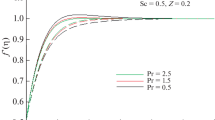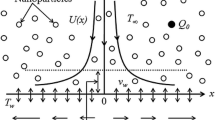Abstract
This paper considers the problem of the two-dimensional mixed convection stagnation-point flow of a magnetohydrodynamic non-Newtonian nanofluid bounded by a vertical stretching sheet. Convective surface boundary and zero surface nanoparticle mass flux conditions are employed. The effects of buoyancy, radiation, Brownian motion, thermophoresis, and viscous dissipation are taken into account. The stretching velocity is assumed to vary linearly with the distance from the stagnation point. The fluid is electrically conducted with uniform magnetic field, and the work done due to deformation is taken into consideration. The three-coupled partial differential boundary layer equations are reduced to ordinary differential equations by using proper similarity transformations. Analytical solution by homotopy analysis method is obtained. Effects of different physical parameters on the dynamics of the problem are analyzed and discussed.


























Similar content being viewed by others
Abbreviations
- \( {\mathbf{A}}_{\text{i}} \) :
-
Kinematic tensors (–)
- \( a,c \) :
-
Positive constants (s−1)
- \( {\mathbf{B}} \) :
-
Magnetic field vector (T)
- \( Bi \) :
-
Biot number (–)
- \( B_{0} \) :
-
Magnetic field component (T)
- \( b \) :
-
Body forces (N m−3)
- \( C \) :
-
Nanoparticles concentration (kg m−3)
- \( C_{\infty } \) :
-
Ambient fluid concentration (kg m−3)
- \( C_{\text{f}} \) :
-
Skin friction coefficient (–)
- \( D_{\text{B}} \) :
-
Brownian diffusion coefficient (m2 s−1)
- \( D_{\text{T}} \) :
-
Thermophoresis diffusion coefficient (m2 s−1)
- \( Ec \) :
-
Eckert number (–)
- \( f \) :
-
Dimensionless velocity function (–)
- \( g \) :
-
Gravity acceleration (m s−2)
- \( G_{\text{T}} \) :
-
Local Grashof number (–)
- \( h_{\text{f}} \) :
-
Convection coefficient (W m−2K−1)
- \( {\mathbf{j}} \) :
-
Electric current (A)
- \( K \) :
-
Viscoelastic parameter (–)
- \( k^{*} \) :
-
Mean absorption coefficient (–)
- \( L \) :
-
Cross-viscous parameter (–)
- \( M \) :
-
Magnetic field parameter (–)
- \( Nb \) :
-
Brownian motion parameter (–)
- \( Nt \) :
-
Thermophoresis parameter (–)
- \( Nu_{\text{x}} \) :
-
Local Nusselt number (–)
- \( Pr \) :
-
Prandtl number (–)
- \( Re_{\text{x}} \) :
-
Local Reynolds number (–)
- \( R_{\text{d}} \) :
-
Radiation parameter (–)
- \( {\mathbf{T}} \) :
-
Cauchy stress tensor (–)
- \( T_{\text{f}} \) :
-
Hot fluid temperature (K)
- \( T_{\infty } \) :
-
Ambient temperature (K)
- \( U_{\infty } \) :
-
External flow velocity (m s−1)
- \( (u,v) \) :
-
Velocity components (m s−1)
- \( u_{\text{w}} \) :
-
Stretching sheet velocity (m s−1)
- \( (x,y) \) :
-
Cartesian coordinate components (m)
- \( \alpha \) :
-
Thermal diffusivity (m2 s−1)
- \( \alpha_{\text{i}} ,\beta_{\text{i}} \) :
-
Material constants (–)
- \( \beta \) :
-
Third-grade fluid parameter (–)
- \( \beta_{\text{c}} \) :
-
Coefficient of mass expansion (K−1)
- \( \beta_{\text{T}} \) :
-
Coefficient of thermal expansion (K−1)
- \( \phi \) :
-
Dimensionless concentration function (–)
- \( \eta \) :
-
Similarity variable (–)
- \( \mu \) :
-
Viscosity (N s m−2)
- \( \nu \) :
-
Kinematic viscosity (m2 s−1)
- \( \theta \) :
-
Dimensionless temperature function (–)
- \( \rho \) :
-
Density (kg m−3)
- \( \rho_{\text{f}} \) :
-
Density of the base fluid (kg m−3)
- \( \rho_{\text{p}} \) :
-
Density of the nanoparticles (kg m−3)
- \( \sigma \) :
-
Electrical conductivity of fluid (S m−1)
- \( \sigma^{*} \) :
-
Stefan–Boltzmann constant (W m−2 K−4)
References
Sakiadis B. Boundary-layer behavior on continuous solid surfaces: I. Boundary-layer equations for two-dimensional and axisymmetric flow. AIChE J. 1961;7(1):26–8.
Sakiadis B. Boundary-layer behavior on continuous solid surfaces: II. The boundary layer on a continuous flat surface. AIChE J. 1961;7(2):221–5.
Erickson L, Fan L, Fox V. Heat and mass transfer on moving continuous flat plate with suction or injection. Ind Eng Chem Fundam. 1966;5(1):19–25.
Ali M, Al-Yousef F. Laminar mixed convection from a continuously moving vertical surface with suction or injection. Heat Mass Transf. 1998;33(4):301–6.
Chen C-H. Laminar mixed convection adjacent to vertical, continuously stretching sheets. Heat Mass Transf. 1998;33(5–6):471–6.
Ali ME. The effect of variable viscosity on mixed convection heat transfer along a vertical moving surface. Int J Therm Sci. 2006;45(1):60–9.
Ishak A, Nazar R, Pop I. Mixed convection boundary layers in the stagnation-point flow toward a stretching vertical sheet. Meccanica. 2006;41(5):509–18.
Ishak A, Jafar K, Nazar R, Pop I. MHD stagnation point flow towards a stretching sheet. Physica A. 2009;388(17):3377–83.
Hayat T, Abbas Z, Pop I, Asghar S. Effects of radiation and magnetic field on the mixed convection stagnation-point flow over a vertical stretching sheet in a porous medium. Int J Heat Mass Transf. 2010;53(1):466–74.
Masuda H, Ebata A, Teramae K. Alteration of thermal conductivity and viscosity of liquid by dispersing ultra-fine particles. Dispersion of Al2O3, SiO2 and TiO2 ultra-fine particles. Netsu Bussei. 1993;7(4):227–33.
Chol S. Enhancing thermal conductivity of fluids with nanoparticles. ASME Publ Fed. 1995;231:99–106.
Buongiorno J. Convective transport in nanofluids. J Heat Transf. 2006;128(3):240–50.
Khan W, Pop I. Boundary-layer flow of a nanofluid past a stretching sheet. Int J Heat Mass Transf. 2010;53(11):2477–83.
Haq RU, Nadeem S, Khan ZH, Akbar NS. Thermal radiation and slip effects on MHD stagnation point flow of nanofluid over a stretching sheet. Physica E. 2015;65:17–23.
Makinde O, Aziz A. Boundary layer flow of a nanofluid past a stretching sheet with a convective boundary condition. Int J Therm Sci. 2011;50(7):1326–32.
Aziz A. A similarity solution for laminar thermal boundary layer over a flat plate with a convective surface boundary condition. Commun Nonlinear Sci Numer Simul. 2009;14(4):1064–8.
Mustafa M, Hayat T, Pop I, Asghar S, Obaidat S. Stagnation-point flow of a nanofluid towards a stretching sheet. Int J Heat Mass Transf. 2011;54(25):5588–94.
Mabood F, Khan W. Analytical study for unsteady nanofluid MHD Flow impinging on heated stretching sheet. J Mol Liq. 2016;219:216–23.
Makinde O, Khan W, Khan Z. Buoyancy effects on MHD stagnation point flow and heat transfer of a nanofluid past a convectively heated stretching/shrinking sheet. Int J Heat Mass Transf. 2013;62:526–33.
Malvandi A, Hedayati F, Ganji D. Slip effects on unsteady stagnation point flow of a nanofluid over a stretching sheet. Powder Technol. 2014;253:377–84.
Mansur S, Ishak A, Pop I. The magnetohydrodynamic stagnation point flow of a nanofluid over a stretching/shrinking sheet with suction. PLoS ONE. 2015;10(3):e0117733.
Rashid I, Haq RU, Al-Mdallal QM. Aligned magnetic field effects on water based metallic nanoparticles over a stretching sheet with PST and thermal radiation effects. Physica E. 2017;89:33–42.
Rahman M, Eltayeb I. Radiative heat transfer in a hydromagnetic nanofluid past a non-linear stretching surface with convective boundary condition. Meccanica. 2013;48(3):601–15.
Rana P, Dhanai R, Kumar L. Radiative nanofluid flow and heat transfer over a non-linear permeable sheet with slip conditions and variable magnetic field: dual solutions. Ain Shams Eng J. 2017;8(3):341–52. https://doi.org/10.1016/j.asej.2015.08.016.
Zaimi K, Ishak A, Pop I. Boundary layer flow and heat transfer over a nonlinearly permeable stretching/shrinking sheet in a nanofluid. Sci Rep. 2014;4:4404.
Malvandi A, Moshizi S, Ganji D. Nanoparticle transport effect on magnetohydrodynamic mixed convection of electrically conductive nanofluids in micro-annuli with temperature-dependent thermophysical properties. Physica E. 2017;88:35–49.
Rashidi S, Mahian O, Languri EM. Applications of nanofluids in condensing and evaporating systems. J Therm Anal Calorim. 2017;8:1–13.
Javadi P, Rashidi S, Abolfazli Esfahani J. flow and heat management around obstacle by nanofluid and incidence angle. J Thermophys Heat Transf. 2017;31(4):983–8.
Bovand M, Rashidi S, Esfahani J. Optimum interaction between magnetohydrodynamics and nanofluid for thermal and drag management. J Thermophys Heat Transf. 2016;31(1):218–29.
Shirejini SZ, Rashidi S, Esfahani J. Recovery of drop in heat transfer rate for a rotating system by nanofluids. J Mol Liq. 2016;220:961–9.
Akar S, Rashidi S, Esfahani JA. Second law of thermodynamic analysis for nanofluid turbulent flow around a rotating cylinder. J Therm Anal Calorim. 2018;2:1–12.
Dunn J, Rajagopal K. Fluids of differential type: critical review and thermodynamic analysis. Int J Eng Sci. 1995;33(5):689–729.
Fosdick R, Rajagopal K, editors. Thermodynamics and stability of fluids of third grade. In: Proceedings of the royal society of London A: mathematical, physical and engineering sciences; 1980. The Royal Society.
Rajagopal K, Szeri A, Troy W. An existence theorem for the flow of a non-Newtonian fluid past an infinite porous plate. Int J Non Linear Mech. 1986;21(4):279–89.
Maneschy C, Massoudi M, Ghoneimy A. Heat transfer analysis of a non-Newtonian fluid past a porous plate. Int J Non Linear Mech. 1993;28(2):131–43.
Sahoo B. Flow and heat transfer of an electrically conducting third grade fluid past an infinite plate with partial slip. Meccanica. 2010;45(3):319–30.
Sahoo B, Poncet S. Flow and heat transfer of a third grade fluid past an exponentially stretching sheet with partial slip boundary condition. Int J Heat Mass Transf. 2011;54(23):5010–9.
Shehzad S, Hussain T, Hayat T, Ramzan M, Alsaedi A. Boundary layer flow of third grade nanofluid with Newtonian heating and viscous dissipation. J Cent South Univ. 2015;22(1):360–7.
Hayat T, Aziz A, Muhammad T, Ahmad B. On magnetohydrodynamic flow of second grade nanofluid over a nonlinear stretching sheet. J Magn Magn Mater. 2016;408:99–106.
Hayat T, Aziz A, Muhammad T, Alsaedi A, Mustafa M. On magnetohydrodynamic flow of second grade nanofluid over a convectively heated nonlinear stretching surface. Adv Powder Technol. 2016;27(5):1992–2004.
Ghasemi SE, Hatami M, Sarokolaie AK, Ganji D. Study on blood flow containing nanoparticles through porous arteries in presence of magnetic field using analytical methods. Physica E. 2015;70:146–56.
Liao S. Beyond perturbation: introduction to the homotopy analysis method. Boca Raton: CRC Press; 2003.
Liao S. On the homotopy analysis method for nonlinear problems. Appl Math Comput. 2004;147(2):499–513.
Liao S-J. An approximate solution technique not depending on small parameters: a special example. Int J Non Linear Mech. 1995;30(3):371–80.
Liao S, Tan Y. A general approach to obtain series solutions of nonlinear differential equations. Stud Appl Math. 2007;119(4):297–354.
Kuznetsov A, Nield D. Natural convective boundary-layer flow of a nanofluid past a vertical plate: a revised model. Int J Therm Sci. 2014;77:126–9.
Rivlin RS, Ericksen J. Stress-deformation relations for isotropic materials. Collected Papers of RS Rivlin. Berlin: Springer; 1997. p. 911–1013.
Pakdemirli M. The boundary layer equations of third-grade fluids. Int J Non Linear Mech. 1992;27(5):785–93.
Acknowledgements
Financial support of Ferdowsi University of Mashhad under Contract No. 2/42929 is acknowledged.
Author information
Authors and Affiliations
Corresponding author
Rights and permissions
About this article
Cite this article
Golafshan, B., Rahimi, A.B. Effects of radiation on mixed convection stagnation-point flow of MHD third-grade nanofluid over a vertical stretching sheet. J Therm Anal Calorim 135, 533–549 (2019). https://doi.org/10.1007/s10973-018-7075-4
Received:
Accepted:
Published:
Issue Date:
DOI: https://doi.org/10.1007/s10973-018-7075-4




